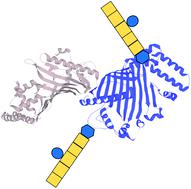当前位置:
X-MOL 学术
›
Mol. Omics
›
论文详情
Our official English website, www.x-mol.net, welcomes your feedback! (Note: you will need to create a separate account there.)
Identifying the targets and functions of N-linked protein glycosylation in Campylobacter jejuni.
Molecular Omics ( IF 2.9 ) Pub Date : 2020-04-22 , DOI: 10.1039/d0mo00032a Joel A Cain 1 , Ashleigh L Dale 1 , Zeynep Sumer-Bayraktar 1 , Nestor Solis 2 , Stuart J Cordwell 3
Molecular Omics ( IF 2.9 ) Pub Date : 2020-04-22 , DOI: 10.1039/d0mo00032a Joel A Cain 1 , Ashleigh L Dale 1 , Zeynep Sumer-Bayraktar 1 , Nestor Solis 2 , Stuart J Cordwell 3
Affiliation

|
Campylobacter jejuni is a major cause of bacterial gastroenteritis in humans that is primarily associated with the consumption of inadequately prepared poultry products, since the organism is generally thought to be asymptomatic in avian species. Unlike many other microorganisms, C. jejuni is capable of performing extensive post-translational modification (PTM) of proteins by N- and O-linked glycosylation, both of which are required for optimal chicken colonization and human virulence. The biosynthesis and attachment of N-glycans to C. jejuni proteins is encoded by the pgl (protein glycosylation) locus, with the PglB oligosaccharyltransferase (OST) enabling en bloc transfer of a heptasaccharide N-glycan from a lipid carrier in the inner membrane to proteins exposed within the periplasm. Seventy-eight C. jejuni glycoproteins (represented by 134 sites of experimentally verified N-glycosylation) have now been identified, and include inner and outer membrane proteins, periplasmic proteins and lipoproteins, which are generally of poorly defined or unknown function. Despite our extensive knowledge of the targets of this apparently widespread process, we still do not fully understand the role N-glycosylation plays biologically, although several phenotypes, including wild-type stress resistance, biofilm formation, motility and chemotaxis have been related to a functional pgl system. Recent work has described enzymatic processes (nitrate reductase NapAB) and antibiotic efflux (CmeABC) as major targets requiring N-glycan attachment for optimal function, and experimental evidence also points to roles in cell binding via glycan–glycan interactions, protein complex formation and protein stability by conferring protection against host and bacterial proteolytic activity. Here we examine the biochemistry of the N-linked glycosylation system, define its currently known protein targets and discuss evidence for the structural and functional roles of this PTM in individual proteins and globally in C. jejuni pathogenesis.
中文翻译:

确定空肠弯曲菌中N-连接蛋白糖基化的目标和功能。
空肠弯曲杆菌是人类细菌性肠胃炎的主要原因,主要与食用制备不充分的家禽产品有关,因为一般认为该生物在禽类中无症状。与许多其他微生物不同,空肠弯曲杆菌能够通过N-和O-糖基化对蛋白质进行广泛的翻译后修饰(PTM),这对于最佳的鸡定殖和人类毒力都是必需的。N-聚糖与空肠弯曲杆菌蛋白质的生物合成和附着由pgl(蛋白质糖基化)位点编码,而PglB寡糖基转移酶(OST)可以实现将七糖N-聚糖从内膜中的脂质载体整体转移至周质内暴露的蛋白质。现已鉴定出七十八种空肠弯曲杆菌糖蛋白(由134个经实验验证的N-糖基化位点表示),包括内膜和外膜蛋白,周质蛋白和脂蛋白,这些蛋白的功能通常定义不清或未知。尽管我们对这一看似广泛的过程的靶标有广泛的了解,但我们仍不完全了解N-糖基化在生物学上的作用,尽管包括野生型抗逆性,生物膜形成,运动性和趋化性在内的几种表型与功能性相关。pgl系统。最近的工作描述了酶促过程(硝酸还原酶NapAB)和抗生素外排(CmeABC)是需要N-聚糖附着以实现最佳功能的主要靶标,并且实验证据还指出了通过聚糖-聚糖相互作用,蛋白质复合物形成和蛋白质在细胞结合中的作用。通过赋予针对宿主和细菌蛋白水解活性的保护来实现稳定性。在这里,我们检查了N-连接的糖基化系统的生物化学,定义了其目前已知的蛋白质靶标,并讨论了该PTM在单个蛋白质中以及在空肠弯曲杆菌发病机理中的结构和功能作用的证据。
更新日期:2020-04-22
中文翻译:

确定空肠弯曲菌中N-连接蛋白糖基化的目标和功能。
空肠弯曲杆菌是人类细菌性肠胃炎的主要原因,主要与食用制备不充分的家禽产品有关,因为一般认为该生物在禽类中无症状。与许多其他微生物不同,空肠弯曲杆菌能够通过N-和O-糖基化对蛋白质进行广泛的翻译后修饰(PTM),这对于最佳的鸡定殖和人类毒力都是必需的。N-聚糖与空肠弯曲杆菌蛋白质的生物合成和附着由pgl(蛋白质糖基化)位点编码,而PglB寡糖基转移酶(OST)可以实现将七糖N-聚糖从内膜中的脂质载体整体转移至周质内暴露的蛋白质。现已鉴定出七十八种空肠弯曲杆菌糖蛋白(由134个经实验验证的N-糖基化位点表示),包括内膜和外膜蛋白,周质蛋白和脂蛋白,这些蛋白的功能通常定义不清或未知。尽管我们对这一看似广泛的过程的靶标有广泛的了解,但我们仍不完全了解N-糖基化在生物学上的作用,尽管包括野生型抗逆性,生物膜形成,运动性和趋化性在内的几种表型与功能性相关。pgl系统。最近的工作描述了酶促过程(硝酸还原酶NapAB)和抗生素外排(CmeABC)是需要N-聚糖附着以实现最佳功能的主要靶标,并且实验证据还指出了通过聚糖-聚糖相互作用,蛋白质复合物形成和蛋白质在细胞结合中的作用。通过赋予针对宿主和细菌蛋白水解活性的保护来实现稳定性。在这里,我们检查了N-连接的糖基化系统的生物化学,定义了其目前已知的蛋白质靶标,并讨论了该PTM在单个蛋白质中以及在空肠弯曲杆菌发病机理中的结构和功能作用的证据。



























 京公网安备 11010802027423号
京公网安备 11010802027423号